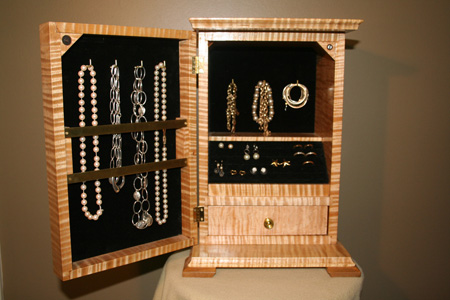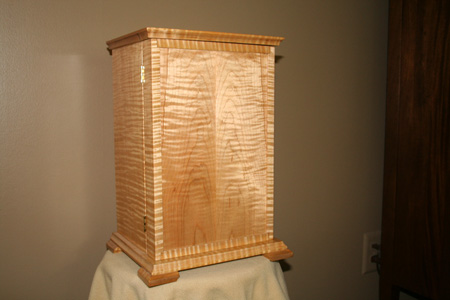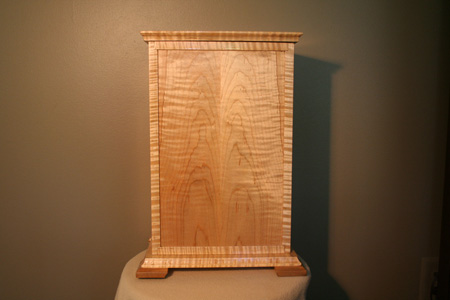
Working With Wonderful Wood
by Dick Rank
Atlanta, GA
For months I had been working from the top of the “Dad, could you make a ---- for me?“ list. The
last half dozen projects were big and easy pieces, like another distressed hutch, a dining room
table with leaves, and several occasional tables. Having recently joined a group of American period
furniture makers, I was inspired to somehow find a project which would bring my skills up to a
higher level. Being somewhat lazy, I have usually preferred making “not so fine” furniture. It
fits my personality. Striving to reach perfection is not my style. At my age, it is simply unwise
to even start a project that might take several years to complete. I have been told that I should
not even buy green bananas.
I truly enjoy the camraderie and the awe that comes from seeing some of my woodworking friends
produce incredibly perfect reproductions of period furniture, but I will never elevate myself to
their level. Not enough patience, I guess. But that is the wonderful part of woodworking. There
is something in woodworking for everyone in it. Wood becomes a willing partner as we each express
who we are through making beautiful objects of wood.
One evening, while mining the information in a new woodworking magazine, I came upon a lovely
small jewelry cabinet plan that seemed like it could inspire me to elevate my skill to a higher level. I
considered it a test to see if I could do an almost perfect job on it. For me, it has always seemed risky to try
for perfection, but the chest had the potential to take me up a notch or two in my skills. Furthermore, I needed a
special gift for my wife for the next Christmas Eve. This cabinet was about 12 inches wide, 8 inches
deep and 18 inches high, with a place to hang necklaces inside the back of the door, a sloped,
grooved shelf for earrings and rings, and hooks for bracelets. A small drawer at the bottom
provided loose storage. The cabinet’s front door offered a chance to show off a bookend pattern of
my finest maple grain.
I had a couple of tiger maple boards that were long enough to meet plan requirements, and the
rippling grain would certainly be a challenge to work with. Tiger maple tends to chip off on the
surface when planed by machine, and even a well honed Stanley hand plane might do the same. When
finished, tiger maple looks a bit dramatic with its bright grain of ripple after ripple, so it was
wise to check with my “good taste” consultant, my wife, before moving ahead. It is always possible
to spend many hours making a project, only to discover that it simply does not look good. With an OK
from her, I worked out the cutting plan, and turned on the saws. I do like good woodworking
machines, so a major part of my pleasure in woodworking is using them. There is always plenty of hand work to
follow.
During the following weeks, I found that spending shorter work periods produced a better product.
I could take my time, making every cut, rabbet and dado as clean and accurate as possible. The
grain of every piece required plenty of hand planing and scraping until each finally become flat,
smooth, and ready for finishing. The project lengthened into several months of short work periods,
and at times it just gathered dust, taking second place to other work. Such a leisurely pace was a
luxury I had never allowed myself in the past.
The maple finished out nicely with a hand rubbed wax applied over polyurethane that was sanded
and rubbed with steel wool, leaving the wood in its natural color. The finished cabinet was good -
nice clean joints and great grain patterns. It is most useful for keeping my wife’s jewelry safe
and organized. It even feels great to the touch.



The jewelry cabinet does look a bit "loud", but it resides in a large closet away from others'
eyes, where we both can enjoy looking at it as a symbol of our life partnership. Also, its
requirements stretched me in significant ways. And best of all, it was a very welcome Christmas
gift.
Wood is certainly nature’s gift to all of us - to see, to shape, to touch and to admire.
Dick can be reached by email at
richardrank4@aol.com
.
Return to
Wood News
front page


